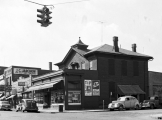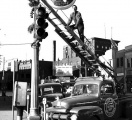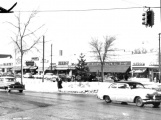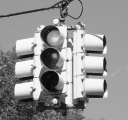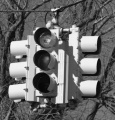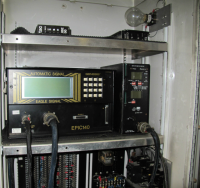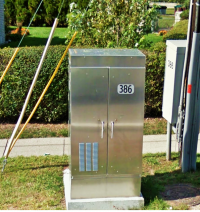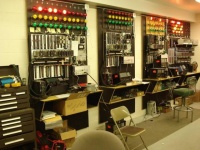Difference between revisions of "Michigan Intersections"
From HighwayWiki
m |
|||
| (10 intermediate revisions by one other user not shown) | |||
| Line 1: | Line 1: | ||
| + | [[File:Work_In_Progress.png]] | ||
| + | <br> | ||
| + | <br> | ||
| + | <br> | ||
| + | <br> | ||
| − | == Macomb County (Part of the Detroit Tri-Counties Region) == | + | == Macomb County Traffic Control History (Part of the Detroit Tri-Counties Region) == |
| + | |||
| + | === Signals === | ||
| + | |||
| + | ==== 1920's - 1930's ==== | ||
| + | <div style="overflow: hidden"> | ||
| + | Essco – first to appear in mt. Clemens, the county seat. This picture shows the Essco model R-4. This signal was produced around 1925. | ||
| + | |||
| + | Tokheim – first to be used in pedestal and side-of-pole installs. Both of these configurations used solid-body adjustable signals. Four ways were used to replace the Esscos and were installed on diagonal spanwires in the late 1930s. | ||
| + | |||
| + | <gallery mode="nolines" widths=200px> | ||
| + | File:ESSCO_Joe.jpg|Ann Arbor Archive | ||
| + | File:Tokheim_Joe.png|Mt. Clemens Installation, Macomb County Library Cooperative | ||
| + | File:Tokheim2_Joe.jpg|Mt. Clemens Installation, Macomb County Library Cooperative | ||
| + | </gallery> | ||
| + | |||
| + | </div> | ||
| + | |||
| + | ==== 1940's - 1960's ==== | ||
| + | <div style="overflow: hidden"> | ||
| + | Eagle ornamental Eagleluxes were used in the first overhead clusters during the early 1940s however production of this signal ceased in the mid 1930's. Conventional Eagle Eaglelux "Tall Fin" KB-x form signals were used through the remainder of the 1940s and 1950s for most of Macomb County’s installs. | ||
| + | |||
| + | The Eagle Sentry, aka rodded flatback, was used after the production run of Eagleluxes ceased sometime around 1958. The solid-section eagle, known as the conventional flatback, was introduced around 1967 and was widely used until eagle launched its line of polycarbonate signals in the mid 1970s. | ||
| + | |||
| + | Econolite – was used by the county sporadically during the mid fifties and early 1960s. Complete installs of Econolite always featured eagle pedestrian signals. Econolite heads and clusters would usually be seen as replacements for eagle heads to be removed due to damage or age. | ||
| + | |||
| + | <gallery mode="nolines" widths=200px> | ||
| + | File:OrnamentalEaglelux_Joe.jpg|Eagle Ornamental Eagleluxes, Nine Mile Road at Gratiot Ave. in East Detroit, Macomb County Library Cooperative | ||
| + | File:RoddedFB_Joe.jpg|Eagle Sentry or Rodded Flatback, Photo by Joe C. | ||
| + | File:EconoSG_Joe.jpg|Econolite Short Groove Signal, Photo by Joe C. | ||
| + | </gallery> | ||
| + | </div> | ||
| + | |||
| + | ==== 1970's - 2000's ==== | ||
| + | <div style="overflow: hidden"> | ||
| + | The first polycarbonate signals appeared in the late 1970s and were Eagle Durasigs. Combo clusters like the ones shown were common where 12" signals were needed on main arterials. | ||
| + | |||
| + | Intersections in the Metro Detroit area changed quite a bit from the late 80s/early 90s till today. During the 90’s we used nearly all Eagle equipment. The signal heads themselves were DuraSig and most controllers were EPIC 140s,EF 140s, or older EPAC 300s housed in slightly smaller NEMA cabinets. Most modern intersections that were replacing the aluminum signals were two yellow 12 inch DuraSig clusters, with a case sign in the middle of a diagonal span wire. Auxiliary 8 inch yellow DuraSigs usually mounted on poles or pedestals along with black 12 inch DuraSig pedestrian signals. The cabinet usually mounted to one of the signal poles. Most intersections in the area at this time, with the exception of Oakland County, had a pretimed setup. No detection of any kind were used in many of the early to mid 90s displays. | ||
| + | |||
| + | In the mid 90s, more intersections were getting left turn signal upgrades. The earliest Left turns signals were back to back two ways for the major street and a “left only” sign in between them for the minor street. Most didn’t do the Michigan red ball flash sequence until a short time later. When left turn signals like these were used, intersections were usually equipped with two three way clusters and two single facers, both facing different directions and the side signals on the three ways facing the minor street. Later on intersections, especially major ones, sported four way clusters for Left turns, with two sets of two way clusters for the thru traffic. Right turn movements were displayed using a single section signal and a right turn arrow. These were wired to the left turn phase’s Phase On connection on the controller. That way, while the left turn phase was active/on (Green arrow, yellow arrow, and all red clearance) of the side street, the right signal on a main street would be on. All these signals were DuraSig and yellow, and on diagonal wire spans, for the most part. | ||
| + | |||
| + | In the later half of the 90’s and up until today Macomb County in particular began switching from using DuraSig vehicle signals to LFE poly models. The LFE polys, which are currently being made by Eagle, started popping up. It is unknown why the change was necessary. It may have been cheaper. Pedestrian signals continued to be black Eagle DuraSigs. LEDs of different brands were showing up around this time. Dialight eventually became the main brand used in the Metro Detroit area. | ||
| + | </div> | ||
| + | |||
| + | ==== 2010 - Present ==== | ||
| + | <div style="overflow: hidden"> | ||
| + | |||
| + | Today, many intersections are getting complete overhauls to fit the demands in traffic these days. Federally approved flashing yellow arrow left turn signals are now replacing the Michigan flashing red ball lefts. Most LEDs used in the area are Dialights, with some GE units here and there. All brand new intersections support DuraSigs or poly LFEs for vehicle signals, and continue to use DuraSigs for pedestrians signals. Although Eagle developed a 16 inch pedestrian signal that is used here for countdown pedestrian signals. Doghouse signals began appearing here for right turn movements. The top section being a Mark IV unit to prevent cracking. | ||
| + | |||
| + | While some aluminum T-Con heads (Nick? The boobie-back non ICC, non-Durasig signals) were still around and a few aluminum Eagles the majority of Macomb was Durasig intersections in both 8" and 12" varieties, everything yellow. Generally 12" were used overhead and 8" were used, if at all, for side-of-pole signals along with two-stacked 12" black Durasig pedestrian signals. Much had been converted to LEDS, often with the ped having a dual indication hand/man LED in one section and the other left non functional. Countdown module conversions were rare. In the mid teens, major corridors along Macomb county, such as Ryan Road, recieved full upgrades, including signal poles, ped poles, and ADA setback requirements, and conversion to either box span or mast arm configurations with flashing yellow arrow left turns in lieu of the traditional diagonal spanwire setups with a flashing red ball for left turns. The equipment installed was slightly more diverse and many new intersections went completely with yellow 12" Econolite "buttonback" poly heads, no side of pole signals, and 16" black countdown peds. | ||
| + | </div> | ||
| + | |||
=== Controllers === | === Controllers === | ||
| + | |||
==== The Solid-State Era ==== | ==== The Solid-State Era ==== | ||
| + | |||
===== First Generation ===== | ===== First Generation ===== | ||
<div style="overflow: hidden"> | <div style="overflow: hidden"> | ||
[[File:Ok68p2.png|200px|thumb|right|EF-140 controller unit. Photo from Signalfan]] | [[File:Ok68p2.png|200px|thumb|right|EF-140 controller unit. Photo from Signalfan]] | ||
| − | Macomb County initially wanted a solid state controller that mimicked the mechanical controllers due to the unusual timing/cycling patterns of Michigan intersections. | + | Macomb County initially wanted a solid state controller that mimicked the mechanical controllers due to the unusual timing/cycling patterns of Michigan intersections. While common to Michiganders it was virtually unheard of outside the state to have a flashing red left turn signal, decades before the "flashing yellow arrow" made a national debut. This feature was originally available on EPIC units and eventually added as a feature on EPAC controller units. In addition, when this red left turn signal was green the perpendicular traffic would have a single section green right turn arrow that would just turn off, no yellow or red phases present to follow. This was an extra interval step on EPICs, phase on input for the cross streets left phase when using EPAC. |
| + | |||
| + | The reversed sequence...thrus cycled first then left turns on most cases. (Nonstandard interval sequences allowed this on EPIC. Alternate sequences and phase pair reversal created this scenario on the EPAC. On phase oriented machines like the EPAC, lefts are odd numbered phases and thru's are even. With reversals set, phase sequence would be 2,1,4,3 or thru, left, thru, left) NEMA phase-oriented machines at the time did not provide as many options and flexibility as they do nowadays. | ||
According to Scott Holzhei of MDOT (user "Kentron" on STF): Eagle Signal was the only manufacturer willing to develop an interval based machine. | According to Scott Holzhei of MDOT (user "Kentron" on STF): Eagle Signal was the only manufacturer willing to develop an interval based machine. | ||
| Line 49: | Line 109: | ||
[[File:34fe1w5.png|200px|thumb|right|Intelight 340 ITS cabinet and disconnected Eagle Size 4 cabinet serving as a splice point.]] | [[File:34fe1w5.png|200px|thumb|right|Intelight 340 ITS cabinet and disconnected Eagle Size 4 cabinet serving as a splice point.]] | ||
| − | |||
| − | |||
The third wave of modernization included most new intersections to be spec’ed with ITS cabinets standard, either Intelight or Siemens, possibly Econolite and McCain as well but haven’t seen evidence of their usage. | The third wave of modernization included most new intersections to be spec’ed with ITS cabinets standard, either Intelight or Siemens, possibly Econolite and McCain as well but haven’t seen evidence of their usage. | ||
| Line 60: | Line 118: | ||
As of October 2008, MDOT timing specifications allow for EF/EPIC and EPAC controllers for State-Maintained roads. [[Media:Mdot_signal_timing_plan_preparation_guidelines.pdf|MDOT Spec]] | As of October 2008, MDOT timing specifications allow for EF/EPIC and EPAC controllers for State-Maintained roads. [[Media:Mdot_signal_timing_plan_preparation_guidelines.pdf|MDOT Spec]] | ||
| + | |||
| + | [[File:eamxdd.jpg|200px|thumb|left|MDOT shop: Testing EPAC 300 M30, EPIC and EPAC M50 controller units.]] | ||
| + | </div> | ||
| + | |||
| + | == Wayne County Traffic Control History: Focusing on Detroit == | ||
| + | |||
| + | A work in progres. -LC | ||
| + | |||
| + | === Signals === | ||
| + | |||
| + | ==== 1920's - 30's ==== | ||
| + | <div style="overflow: hidden"> | ||
| + | 1920's | ||
| + | |||
| + | Potts Signal | ||
| + | While there were many semaphore devices and some two light signals it is generally accepted that Detroit Police Offier William Potts developed the first traffic light to have a third aspect, the amber light, for clear indication of the traffic change period. His initial signal was built out of wood and covered with black tin plate for protection from the elements. It was similar in size and spanwire mounted like a conventional 4-way traffic light. Internally it used a single 100W bulb per section meaning perpindicular traffic would have seen their red light on bottom and green light on top. All directions would see the amber light to indicate the traffic change althought it's not known if it was an independant indication or if it was an overlap. In addition, like much of the Detroit equipment at the time it was powered at 220V. | ||
| + | |||
| + | After demonstrating this light in service and seeing the results he proceeded to have several more constructed. Four of these signals were installed along Woodward Avenue at Grand River, Congress, State St. and Fort St. All were controlled simultaneously by a manual traffic tower located at Michigan and Woodward. | ||
| + | |||
| + | The 1920's and 1930's were a rapidly developing time of traffic control equipment with the groundwork laid by the many pioneers directly guiding traffic development for the century to come. Detroit as a city was developing rapidly too and it was decided one way or another not to continue the in-house development of traffic signals and instead purchase them from commercial sources. | ||
| + | |||
| + | William Potts (left) with his original signal: | ||
| + | |||
| + | |||
| + | WSU collection | ||
| + | |||
| + | |||
| + | The original signal displayed at the Henry Ford Museum: | ||
| + | |||
| + | Joe Conflitti | ||
| + | |||
| + | Shorpy Photo | ||
| + | |||
| + | ************** | ||
| + | |||
| + | Tokheim and Essco | ||
| + | These two short lived signal manufacturers represented the first commercial mass-produced and implemented signals in Detroit. Esscos were used in fixed 4-way variety from the mid-1920s through the early 1960s. [do we have evidence of other than the darley style] Tokheims were used in adjustable single and cluster configurations fromthe mid-1920s through the mid 1980s. Both Esscos and Tokheims were most often pedestal or side-of-pole mounted at intersection corners. | ||
| + | |||
| + | |||
| + | Generally the signals Detroit purchased at the time were of bog standard manufacture. Some of the 4-way ESSCO's, at least, were purchased as cast iron models with side pole mounts instead of aluminum bodied signals. | ||
| + | Detroit favored the diffusing or crosshatch "command style" lens but without any command wording and had them installed in all manners of signals purchased in the 1920's and 30's. As well, it appears they only purchased 8 3/8" lensed signals, the Potts experiment being the only time unconventional lense sizes were experimented with. Cap visors were standard as the tunnel and full circle visors were rare anywhere at that time. That did not stop the creativity of the Public Lighting Department as sometime in the 50+ year life of these signals both Tokheim and ESSCO would be retrofitted with homemade tunnel visors utilizing Tokheim mounting tabs either on the amber or all aspects. | ||
| + | |||
| + | The controllers installed at this time were all Tokheim 220V models in the large cast iron cabinets. A few of these cabinets remain in service in 2013 retrofitted with flasher modules or other stored hardware. | ||
| + | |||
| + | Tokheim 2-way pedestal-mount cluster: | ||
| + | |||
| + | WSU Collection | ||
| + | |||
| + | Tokheim cluster at Michigan and Griswold: | ||
| + | |||
| + | Ebay Photo - Looking for owner | ||
| + | |||
| + | Essco 4-way at Second and W Lafayette: | ||
| + | |||
| + | WSU Collection | ||
| + | |||
| + | |||
| + | </div> | ||
| + | |||
| + | ==== 1940's ==== | ||
| + | <div style="overflow: hidden"> | ||
| + | |||
| + | </div> | ||
| + | |||
| + | ==== 1950's ==== | ||
| + | <div style="overflow: hidden"> | ||
| + | |||
| + | </div> | ||
| + | |||
| + | ==== 1960's - 1970's ==== | ||
| + | <div style="overflow: hidden"> | ||
| + | |||
| + | </div> | ||
| + | |||
| + | ==== 1980's - Today ==== | ||
| + | <div style="overflow: hidden"> | ||
| + | |||
</div> | </div> | ||
Latest revision as of 00:29, 13 July 2016
Contents
Macomb County Traffic Control History (Part of the Detroit Tri-Counties Region)
Signals
1920's - 1930's
1940's - 1960's
1970's - 2000's
2010 - Present
Controllers
The Solid-State Era
First Generation
Second Generation
Third Generation
Fourth Generation
Wayne County Traffic Control History: Focusing on Detroit
A work in progres. -LC


